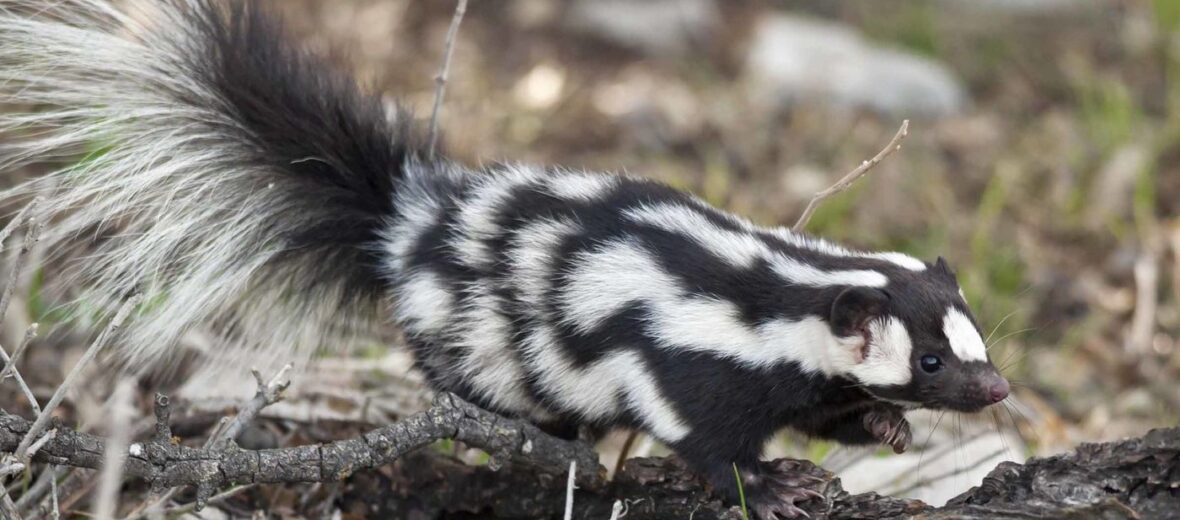
The eastern spotted skunk, aka civet cat, can be found throughout the eastern half of North America, from a small portion of southern Canada, all the way down to the north eastern tip of Mexico.They prefer tall-grass prairies as well as wooded areas and typically like rocky habitats as well. These pretty but smelly critters are listed as Vulnerable by the IUCN. They face the threats of habitat destruction, hunting, trapping, pollution, vehicle strike (being hit with motor vehicles), disease, and invasive species. Sadly, their numbers are decreasing.
First the Stats…
Scientific name: Spilogale putorius
Weight: Up to 1.3 lbs.
Length: Up to 12 inches, plus up to a 7.5 inch tail
Lifespan: Up to 10 years
Now on to the Facts!
1.) Eastern spotted skunks are social animals that often share the same den.
2.) While they may sleep more in the winter, they aren’t known to hibernate (enter into a state of dormancy).
3.) A group of skunks is called a surfeit.
4.) When faced with a threat or a predator, they will stand on their forefeet, with their tail in the air, and aim their musk glands at the threat.
5.) Their first defense, however, is to freeze in place, or scurry up a tree.
But wait, there’s more on the eastern spotted skunk!
6.) These omnivores (eat plant and animal matter) feast on corn and cattails, in the winter months. During fall and spring they eat fruit and insects. In summer they prey on insects, mice, birds, and bird eggs.
7.) Their primary predators are great horned owls, coyotes, bobcats, and humans.
Did you know…?
Like honey badgers, these skunks will knock down beehives to get at the tasty honey; regardless or being stung numerous times. Gluttons for punishment, I guess.
8.) The eastern spotted skunk is polygynous (1 male mates with multiple females).
9.) Females undergo up to a 65 day gestation (pregnancy) that yields up to 6 pups.
10.) Pups are born altricial (blind and helpless).
But wait, there’s still more on the eastern spotted skunk!
11.) These are the only known skunks that are able to climbs trees and fences, with ease.
12.) As proof of their intelligence and a testament of learned behavior, these skunks have been seen rolling caterpillars to remove venomous spines and rolling beetles to force them to expel their pungent chemicals, before eating them.
13.) The amber colored and oily musk that skunks spray can take months to fade from objects. It takes days to weeks to come clean of skin, hair, and fur.
Did you know…?
A skunk can spray its oily, smelly musk an average of over 10 feet and with surprising accuracy!
14.) Their spray is a mixture of sulfurus chemicals like thiols (aka mercaptans). It is so strong that it can even ward off bears!
15.) The musk of a skunk is actually flammable.
But wait, there’s still a little more on the eastern spotted skunk!
16.) Skunks have the ability to transmit rabies. But not all skunks have rabies.
17.) Their spray can cause nausea, vomiting, temporary blindness, and can be detected for up to a mile or more away!
18.) Tomato juice actually isn’t the best remedy for skunk spray. The best concoction is to use a combination of hydrogen peroxide and baking soda. Tomato juice only masks the scent. The previously mentioned elixir will actually counteract the smell.
Now a Short Eastern Spotted Skunk Video!
Be sure to share & comment below! Also, check out the Critter Science YouTube channel. Videos added frequently!
Want to suggest a critter for me to write about? Let me know here.



